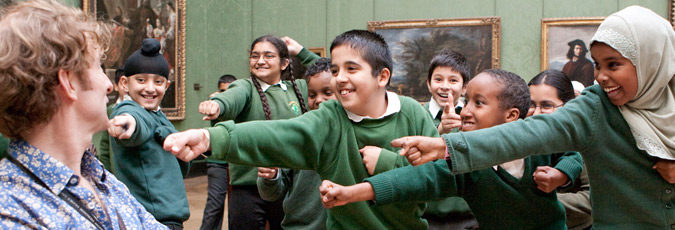Get inspiration from pupils' project work - for primary and secondary teachers.
Introduction
Transcript
An introduction to the Out of Art into Storytelling project, with excerpts from three schools' storytelling performances
Narrator: Out of Art into Storytelling developed both teachers' and pupils' skills as storytellers. They learned how to immerse themselves in a painting through guided looking, to unravel the stories within them through discussion and drama, and then to tell their own versions.
The children initially used story maps to help them remember the stories, but soon they could tell them from memory – sometimes lasting as long as 10 minutes!
Boy 1: "I can see!" said Tobit. "Indeed you can." But maybe he could see better than Tobias and Sara, because when he looked at Raphael, he didn't see the tribesman who helped him for many miles. No, he saw a man with a light... or could that just be the sun? No, he saw a man with glimmering silver wings. Or maybe it was because he was so blind for so long? But as the light went, so did Raphael. "Now I can see!" chuckled Tobit.
Narrator: Children from Year 1 to Year 6 told their stories to their friends and to their parents. The children's passion was reflected in their writing.
Pupils told the stories in different ways. This animation is the product of a collaboration with the local city learning centre. Pupils were taught animation techniques over which they improvised the voice-over to recount 'The Adventures of Perseus'.
Boy 2: "Aha, I’ve got the head! Polydectes will be in trouble!"
Narrator: Significantly, the confidence the children had gained from working with paintings with known stories transferred to those without. They succeeded in creating their own stories from paintings that only suggested narrative.
Girl 1: "Once, long, long ago, back in the mist of time, Atticus lived in a little town, with his lovely, charming wife..."
Get inspired
See a selection of pupils' project work from Out of Art into Storytelling.
What the teachers say
Katie Love from Wroughton Junior School, Wiltshire
"The biggest thing was enabling me to give the children confidence to be storytellers."
Zoe Humberstone from Tealby School, Lincolnshire
"It’s been the glue that has brought the curriculum together across the school."
Doris Yohannes, St.Joseph’s Catholic Primary School, London
"The paintings add so much atmosphere, so much colour to their writing."
Tom Gray from Halstow Primary School, London
"From the moment I showed them the paintings, my class was hooked and produced some of the best writing I have ever seen."
See full case study of Tom's class
Get involved
If you are a teacher of primary school-aged children or secondary school English, you could join in our next Out of Art into Storytelling project. Check the website for dates of forthcoming courses.
Seeing the paintings at the National Gallery is the natural starting point for a project. Find out how to arrange a school visit.
Project evaluation
Cambridge University's Faculty of Education evaluated the Out of Art into Storytelling project.
Dominic Wyse and Laura McGarty, University of Cambridge, Faculty of Education:
"There is powerful evidence from the participants of the Out of Art into Storytelling project of the potential of pedagogy inspired by visual art to transform pupils' storytelling."
Credits

Twenty-five teachers from 11 London schools took part in the pilot Out of Art into Storytelling project. A number of people and organisations contributed expertise to the project. See list of project participants.
Problems opening files? Get Adobe Reader [External link]

